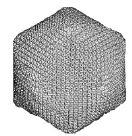Plant Pathology, Department of

James Van Etten Publications
Document Type
Article
Date of this Version
7-2014
Citation
Planta. 2014 July ; 240(1): 209–221. doi:10.1007/s00425-014-2075-5.
(Archived here is the version found on NIH's PubMed Central, PMC4148780; http://www.ncbi.nlm.nih.gov/pmc/articles/PMC4148780/ )
Abstract
Main conclusions A Chlorovirus aquaglyceroporin expressed in tobacco is localized to the plastid and plasma membranes. Transgenic events display improved response to water deficit. Necrosis in adult stage plants is observed.
Aquaglyceroporins are a subclass of the water channel aquaporin proteins (AQPs) that transport glycerol along with other small molecules transcellular in addition to water. In the studies communicated herein, we analyzed the expression of the aquaglyceroporin gene designated, aqpv1, from Chlorovirus MT325, in tobacco (Nicotiana tabacum), along with phenotypic changes induced by aqpv1 expression in planta. Interestingly, aqpv1 expression under control of either a constitutive or a root-preferred promoter, triggered local lesion formation in older leaves, which progressed significantly after induction of flowering. Fusion of aqpv1 with GFP suggests that the protein localized to the plasmalemma, and potentially with plastid and endoplasmic reticulum membranes. Physiological characterizations of transgenic plants during juvenile stage growth were monitored for potential mitigation to water dry-down (i.e., drought) and recovery. Phenotypic analyses on drought mimic/recovery of juvenile transgenic plants that expressed a functional aqpv1 transgene had higher photosynthetic rates, stomatal conductance, and water use efficiency, along with maximum carboxylation and electron transport rates when compared to control plants. These physiological attributes permitted the juvenile aqpv1 transgenic plants to perform better under drought-mimicked conditions and hastened recovery following re-watering. This drought mitigation effect is linked to the ability of the transgenic plants to maintain cell turgor.
Captions for Supplemental figures, Tables S1-S3
Bihmidine et al PLANTA SUPPL figures.pdf (1792 kB)
Supplemental figures S1-S5


Comments
© Springer-Verlag Berlin Heidelberg 2014. Used by permission.